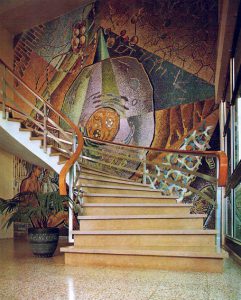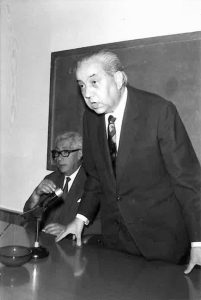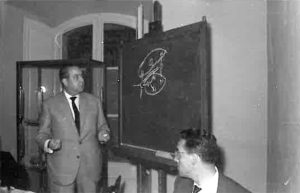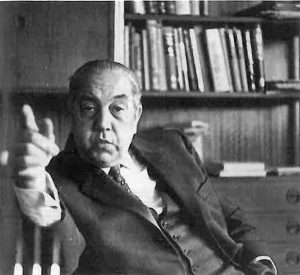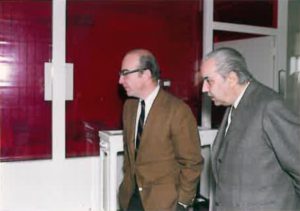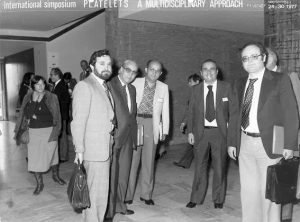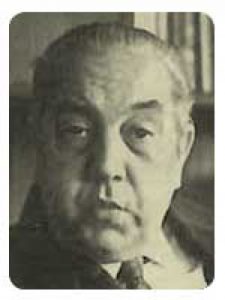
His son, Pere Puig Parellada, was kind enough to talk about Puig Muset's passions and life journey in the following lines, written on November 2011, for the centenary of his birth.
He completed his primary education in his hometown, at the Col·legi Sant Miquel of Molins de Rei, and his secondary education at the Col·legi Ibèric of Barcelona. He began his university degree at the Faculty of Pharmacy of the University of Barcelona, but due to political reasons of the time, finished it at the Faculty of Pharmacy of Granada in 1935.
Once he had completed his degree he decided to start studying ‘seriously;' Professor Francisco García Valdecasas puts it very elegantly when referring to his days as a student: "he spent more time in the humanities than in the sciences courtyard." This period of intense training began at the Pharmacy of the Hospital Clínic (Clinical Hospital of Barcelona), where Dr. Jesús Isamat trained him in the techniques of clinical analysis. He also frequented the analysis laboratory serviced by Professor Ferrer Solervicents and, in the afternoons, the Municipal Laboratory, where he attended a course in Bacteriology and Serology taught by the director, Juan Pedro González, with a long period of practical classes afterwards.
There, between guinea pigs and rabbits, his interest and pleasure in biological research flourished. In 1935, just after graduation, he took up a municipal position of Head Pharmacist for the Molins de Rei City Council, a post he held until 1972. In 1944 he was appointed Assistant Technician of the Pharmacology Section of Barcelona dependent on the Spanish National Research Council (CSIC), with an annual bonus of 500 pesetas.
Vitamin E
The following text is a record of his interest in research and the beginning of one of his research projects: "Finally there was a chance to put into practice the wish to carry out research. In Molins there had been a true famine during the war, and some families who for months only had a daily ration of sweet peas to eat, presented disorders of paralysis of the limbs which doctors Emili Ley and Carles Olivera diagnosed as an epidemic of lathyrism (caused by the excessive consumption of these legumes).
I began a study to determine whether the lack of vitamin E could be of importance among the causes responsible for this condition. To this end, I extracted the lipid fraction (fat) of the legumes and to compare its vitamin E content, I extracted the oil from corn with an elevated and known level of tocopherol (a chemical compound with vitamin E activity). The result was negative, lathyrism was not a vitamin E deficiency. But on the work table remained wheat germ oil. And on a timely visit, the beloved family doctor Pere Puig Roig explained that this product was used in many countries as a medicine: natural vitamin E, fully used in the treatment of sterilization and other pathogenic processes. Furthermore, around that time, there was no preparation of vitamin E. There was a green light for the project. It was time for a pharmaceutical specialty."
And so began a long period-a whole life in fact-devoted to grow the PEVYA Laboratory, founded in 1944 as a laboratory annex to Pharmacy. Three years later a plot of three thousand square meters was bought on number 161 of Verdaguer street, in Molins de Rei, where the different industrial premises were built. The following year, on 1948, all the laboratory was moved to new the facilities. Later on, in 1969, due to the expropriation of the land to build a highway, the laboratory was once again moved to new facilities (4010 m2 of built premises in a land plot of 4038 m2) on number 6 of Santiago Ramon y Cajal street, also in Molins de Rei.
With regard to the name of the laboratory, it was registered on 7 October 1944. The abbreviation PEVYA refers to Productos Extractivos de Vegetales Y Animales (Animal and Plant Extractive Products). Initially the plant products were vitamins E and P, and years later, the animal products were related to obtaining pancreatic and hepatic enzymes. According to Puig Munset, "I am in love with this name, because I do not like personal names in a company."
During the early years of the laboratory, a close and fruitful collaboration was established with the Department of Pharmacology headed by Professor Francisco García Valdecasas. Puig Munset was one of his first collaborators. Even after the creation of a research department in the laboratory, the contact and relation both with professor Valdecasas and his disciples-all persons of high academic and scientific value, such as Josep Mari Massons, Josep Antoni Salvà, Eduard Cuenca, Francesc Jané, and Xavier Forn, among others-was maintained throughout life.
The path of research
Dr. Valdecasas, in the extraordinary in memoriam public session, organized by the Royal Academy of Pharmacy and the Catalan Society for Pharmacology in 1982, summed up in four doctor Puig Munset's fundamental research lines: 1) the biological action of oxygen radicals and the importance of ‘antioxygen' substances (known today as antioxidants); 2) the study of possible pharmacological actions produced by enzymes; 3) the action of glutamic acids and its derivatives in liver failure; and 4) obtaining new biologically active chemical products.
With regard to the first point it must be said that it was the topic that most fascinated him and to which he was faithful throughout his career. He published three books, the first was Introducción al estudio de la Vitamina E (Introduction to the Study of Vitamin E, 1945), the second Los hidro-metabolitos y las enfermedades de la civilización (Hydrometabolites and civilization's diseases, 1954), and the third Oxigeno-s (Oxygen-s, 1976).
Regarding the pharmacological actions of enzymes, the first enzyme they purified was liver catalase, which they named heptocatalase, a clear way of defining an enzyme. They also isolated lipoxidase. The first enzyme demonstrated its lack of toxicity in animals and its limited anaphylactic action in subcutaneous application, which allowed for some clinical trials that resulted in interesting clinical applications in the treatment of gout and other degenerative diseases.
They also purified pancreatic enzymes trypsin and α-chymotrypsin. The pharmacological studies demonstrate the almost absolute harmlessness for α-chymotrypsin, even intravenously, while trypsin showed a high toxicity resulting in widespread thrombosis in laboratory animals, which caused death within minutes. The safety of α-chymotrypsin led to its therapeutic use in conditions that led to fibrosis and adhesion.
One of the most brilliant applications of α-chymotrypsin was in the surgical treatment of cataracts (1957). This was the work of Dr. Joaquim Barraquer in collaboration with the laboratory. They demonstrated that the application of the enzyme in the anterior chamber of the eye produced a selective destruction of the fibers of the zonule, a series of fibers connecting the ciliary body and lens of the eye, holding the lens in place, and so the lens remained floating in the aqueous humor, allowing to operate for cataracts at any age, without having to wait until maturity. This technique became internationally known as enzymatic zonulolysis.
In relation to the third line of research, derivatives of glutamic acid in liver failure, it was intended to demonstrate the possible protective action of glutamic acid, a component of glutathione, a potent antioxidant, in front of liver failure due to alcohol and chloroform. In these studies it was shown that glutamic acid was poorly tolerated intravenously, making it inadequate for future clinical use.
Therefore, γ ethyl ester from glutamic acid (1954) was synthesized, which was better tolerated and more effective than glutamic acid. The result of these experimental studies was that in 1957 the specialty Argi-Glutamyl appeared, indicated for alterations due to dysmetabolism of the ammonium ion present in liver coma and precoma, after a treatment of portocaval anastomosis, in hyperammonenias, liver failure, etc. The product's formula was l-arginine, γ ethyl ester of glutamic acid and carbamoyl l-glutamate.
In 1972, some American researchers published a paper showing that the association of carbamoyl l-glutamate and l-arginine protected from poisoning from ammonium. These researchers' results fully supported Puig Muset's results and thus a clear recognition of his clinical and experimental work.
In the area of drug synthesis emphasis should be placed on the synthesis of cyanoacetic acid hydrazide (1952), a potent anti-tuberculosis substance, similar to isoniazid but with less toxicity. As an anecdote, this pharmaceutical specialty, marketed as Armazal was prescribed to Barça's star player at the time, Ladislao Kubala. After a few months of treatment and once discharged he reappeared at the stadium in Les Corts. All the Puig Munset family attended the game to follow the player's evolution and alert to see if he needed to be replaced. None of that happened, he endured the statutory 90 minutes in perfect health. They returned home satisfied with the efficacy of the treatment.
More recently, in the 1970s, he was strongly interested in imidazole, a molecule that forms part of histamine (the chemical mediator in allergic reactions) and is found at the active site of many enzymes. With this substance he carried out a fairly extensive study published in a book that collected the results obtained and that of course was entitled Imidazole. One of the most interesting results, and perhaps and unexpected one, was this substance's antiadhesive action on platelets (to prevent thrombosis or blood clots for example), an activity he obtained at very low concentrations, much lower than those necessary to achieve other effects such as analgesia, anti-inflammatory activity, etc.
The interpretation of these results was not easy at the time since it was linked to the formation of cyclic adenosine monophosphate or c-AMP. In 1977, doctor Moncada carried out assays of imidazole as a possible inhibitor of the enzyme thromboxane synthase (which can lead to thrombosis) with very clear results: it was a powerful inhibitor. This result allowed for a very suggestive interpretation of the results obtained by Puig Munset and its dissemination.
Academic work
Going back to professor Valdecasas' words, "Puig Munset's character was not inclined to vanity. He preferred well-founded merit to holding positions of titles." Certainly, he did not receive many titles or hold many positions, and some that were offered, he did not accept. Nonetheless, he was the founder and first president of the Catalan Society for Pharmacology. He remained in office for two terms (1958-1963), because of the imprisonment of the society's secretary, doctor Jordi Pujol i Soley, he felt it was incorrect and inappropriate to renew the board without his presence.
In 1965 he entered the Royal Academy of Pharmacy of Barcelona. The entry lecture was entitled ‘The peroxidation processes in pathophysiology and its pharmacological interest." In other words, he spoke about his area of research.
In the last years of his life he was unanimously elected to hold a seat at the Royal Academy of Medicine of Barcelona. Unfortunately, he did not have the heart to accept and refused pronouncing the official speech required in order to be sworn. This painful decision was related to his delicate health. It is also worth noting that in the reactivation of the Catalan Society for Biology, an affiliated society of the Institute for Catalan Studies, he was appointed member of the new board. Apart from his dedication to science and research, he also invested many hours in commercial and industrial activities.
Although these aspects were not to his liking, it is also true that it was necessary to dedicate many hours to them, because the company's continuity depended on it. One of the activities he did like was the preparation of brochures of the new specialties. They were brochures with extensive scientific information and bibliography that allowed physicians to have very complete pharmacological and clinical information. The laboratory's principle was to always provide novel specialties and therefore it was very important to provide this information. It was necessary to communicate the product's features in some depth, because there were no pervious references. In 1974 the PEYVA Laboratory was sold to the Belgian pharmaceutical company UCB.
After the sale, Puig Munset continued to be interested in research topics, sometimes on those that had captivated him for personal or social reasons. One of these was ‘salt' given his cardiologist's recommendation that he reduce his daily intake. He found the topic inspiring enough to make a comprehensive literature search that resulted in a book published in 1981 under the title La sal. Un absurdo desbarajuste (Salt. An absurd mess). The title is explicit enough.
In 1981 he published a paper that defined a new syndrome, of the adulterated oil, which would result in 350 deaths and affected 20,000 people in Spain. Given the importance of the topic, Puig Muset considered it appropriate and even ethical to express his point of view on the subject. To do so, he prepared a monograph (1982) which raised the possible importance of oxygen free radicals and metabolites of arachidonic acid both as generators of free radicals and for their physiological actions. This monograph was sent to all the people involved in the issue, in political and clinical spheres, with the intention to provide a possible new way of tackling the issue, properly reasoned and supported by the appropriate bibliography.
The response to these submissions was nil or a thank you letter of acknowledgement at the most. Nobody felt that the issue was relevant, or at least Spanish researchers did not, for some foreign ones thought otherwise. In this regard, and as an example, it should be emphasized that in Barry Haliwell and John Gutteritge's book Free Radicals in Biology and Medicine, there are a few lines dedicated to the toxic oil, ending with the phrase, "of this issue, the only good thing that resulted was the creation of an international society for the research of free radicals."
This was his last contribution to science as time ran out and oxidative mechanisms gained the upper hand.
- Introducción al estudio de la Vitamina E (Puig Muset, 1945). Editorial Miguel Servet, Barcelona.
- Los hidro-metabolitos y las enfermedades de la civilización (Puig Muset, 1954). Llibreria Editorial Argos, Barcelona.
- Los procesos de peroxidación en fisiopatología y su interés farmacológico(Puig Muset, 1965). Discurs d'ingrés a la Real Academia de Farmacia de Barcelona.
- Peroxidaciones, radical superóxido y oxígeno singlete (Puig Muset, 1975). Sessió inaugural de la Real Academia de Farmacia de Barcelona.
- Oxígeno(s): confrontaciones baconianas sobre unos datos del pasado, del presente y del futuro (Puig Muset, 1976). Editorial Oikos-Tau.
- Valdecasas, F. G.; Laporte J.; Puig-Parellada, P. (1995). Pere Puig Muset. Passió pels oxígens. Barcelona.
- Uriach, J. (2011). Memòries del doctor Biodramina. Barcelona: Edicions 62.
We would like to thank professor Pere Puig Parellada for his help in compiling this biography.
- Photo 1. Portrait of Pere Puig Muset published in the book Passió pels oxígens.
- Photo 2. Pere Puig Muset and Nobel Prize Arthur Kornberg.
- Photo 3. Pere Puig Muset, second left, in a symposium on 1977.
- Photo 4. Mural decoration at the entrance of the Pevya Laboratories that reproduces a cell viewed under the electron microscope.
- Photo 5. Pere Puig Muset and Dr. Calvet of the UB (Universitat de Barcelona).
- Photo 6. Pere Puig Muset at class.
- Photo 7. Pere Puig Muset.

